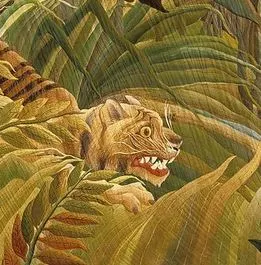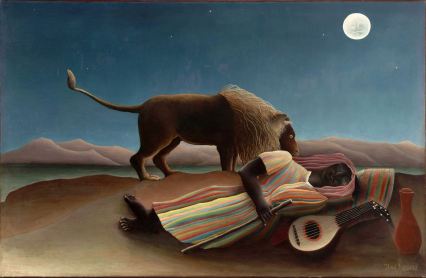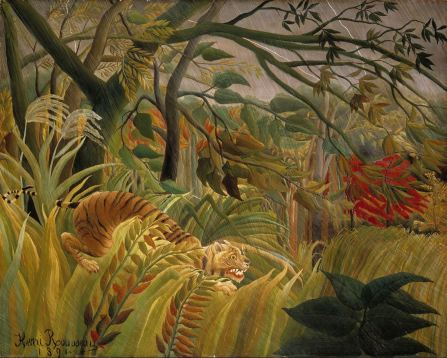
Artist Henri Rousseau (1844 – 1910) used a mix of zoological, museum and artistic sources, combined with a strong imagination, to bring exotic locations and wildlife to life.
Rousseau worked as a toll (tax) collector in Paris and had no formal training in art. As a result, his style is considered to be ‘naïve‘ but he is also considered to be a symbolist artist because of the dreamlike quality of a number of his works.
He never left France, but gave the impression that he had travelled to foreign places and had served in the military in the jungles of Mexico. In fact, during his term of military service he had met soldiers who had survived the French expedition to Mexico (1862–65) in support of Emperor Maximilian, and he listened with fascination to their recollections. Their descriptions of the subtropical country were most likely to be the first inspiration for the exotic landscapes that later became one of his major themes.
When he painted such subjects, such as The Sleeping Gypsy, he worked from his observations at les Jardins de Paris which contained botanical gardens, a zoo, and natural history museum. The flora and fauna on display there inspired much of the lush and exotic imagery seen in his jungle paintings.
Stuffed animal specimens constituted a large portion of its collections – there were some 23,000 bird and 6,000 mammal species on view. Placed in glass display cabinets, they were often positioned in dramatic poses, based both on nature and sculptural tradition.
Rousseau also copied other artists’ paintings at the Louvre as well prints from books.

Rousseau’s Tigers

Surprised! (or Tiger in a Tropical Storm) was painted by Rousseau in 1891 and was the first of his jungle paintings. It shows a tiger, illuminated by a flash of lightning, preparing to pounce on its prey in the midst of a raging gale.
The tiger’s prey is beyond the edge of the canvas, so is it left to the imagination of the viewer to decide what the outcome will be, although Rousseau’s original title Surprised! suggests the tiger has the upper hand. Rousseau later stated that the tiger was about to pounce on a group of explorers. Despite their apparent simplicity, Rousseau’s jungle paintings were built up meticulously in layers, using a large number of green shades to capture the lush exuberance of the jungle. He also devised his own method for depicting the lashing rain by trailing strands of silver paint diagonally across the canvas, a technique inspired by the satin-like finishes of the paintings of William-Adolphe Bouguereau.
At this time Parisians was captivated by exotic and dangerous subjects, such as the perceived savagery of animals and peoples of distant lands. Tigers on the prowl had been the subject of an exhibition at the 1885 École des Beaux-Arts and Rousseau’s tiger may have been derived from the drawings and paintings of Eugène Delacroix.

Unable to have a painting accepted by the jury of the Academie de Peinture et de Sculpture because he had not been formally trained, Rousseau exhibited the painting under the title Surpris!, at the Salon des Indépendants where it received mixed reviews.
Although Surprised! brought him some recognition, and he continued to exhibit his work annually at the Salon des Indépendants, Rousseau didn’t return to the jungle theme for another seven years, with the exhibition of Struggle for Life (now lost) at the 1898 Salon.
Responses to his work hadn’t changed. Following this exhibition, one critic wrote, “Rousseau continues to express his visions on canvas in implausible jungles… grown from the depths of a lake of absinthe, he shows us the bloody battles of animals escaped from the wooden-horse-maker“. *
Another five years passed before his next jungle scene was painted: Scouts Attacked by a Tiger (1904). The tiger appears in several more of his paintings: Tiger Hunt (c. 1895), in which humans are the predators; Jungle with Buffalo Attacked by a Tiger (1908); and Fight Between a Tiger and a Buffalo (1908).
In 1905 Rousseau was invited to exhibit at the Salon d’Automne where his painting The Hungry Lion (1905) was hung in the same room as the works of the group of avant-garde painters known as the Fauves. The critics now began to speak of Rousseau in a positive light, and artists such as Matisse, Picasso and Robert Delauney expressed admiration for his style.
Ambroise Vollard, the most important dealer in modern paintings in Paris at the time, bought Surprised! and two other works from Rousseau, who had offered them at a rate considerably higher than the 190 francs he finally received.
* Morris, Frances and Christopher Green, eds. (2006 [2005]). Henri Rousseau: Jungles in Paris. New York: Abrams
One of the things I really enjoy about Rousseau’s paintings is his use of colour, which works so well to create atmosphere. In particular you can see how he has used many shades of green (green is not any easy colour for artists to work with) to great effect, and I think this is one of the reasons why his art is so enduring. If you like Rousseau’s work, what do you find most captivating?
This blog is just a short excerpt from my art history e-course, Introduction to Modern European Art which is designed for adult learners and students of art history.
This interactive program covers the period from Romanticism right through to Abstract Art, with sections on the Bauhaus and School of Paris, key Paris exhibitions, both favourite and less well known artists and their work, and information about colour theory and key art terms. Lots of interesting stories, videos and opportunities to undertake exercises throughout the program.
If you’d like to see some of the Australian artwork you’ll find in my gallery, scroll down to the bottom of the page. You’ll also find many French works on paper and beautiful fashion plates from the early 1900s by visiting the gallery.






